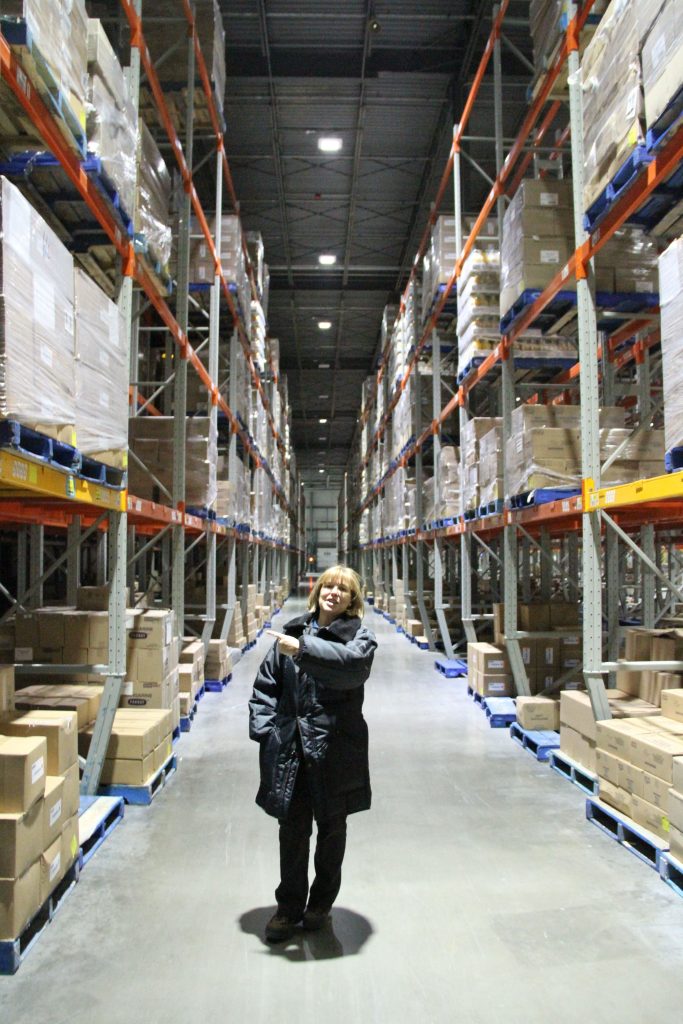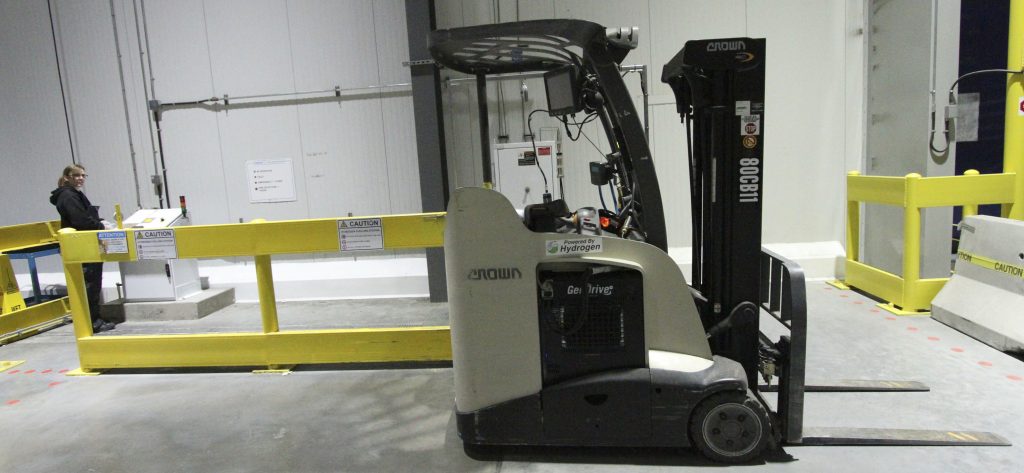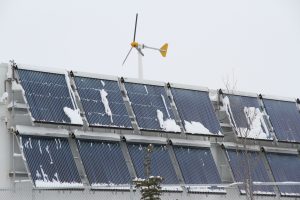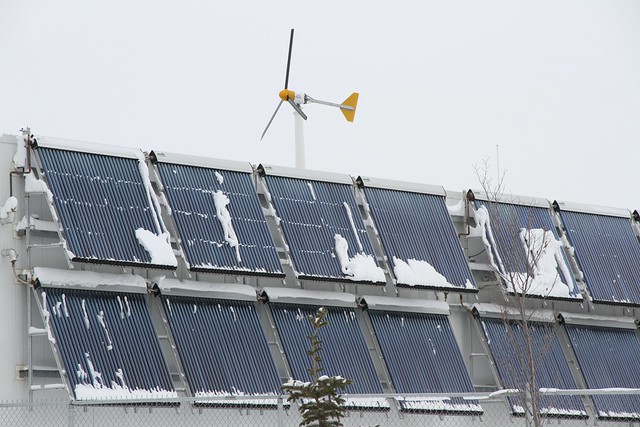By David Dodge and Duncan Kinney
As you walk past two wind turbines, a rack of solar thermal modules and a large vertical hydrogen tank to get into Walmart’s western Canadian perishable food distribution centre in Balzac Alberta you might think this little ode to sustainability might be over. But head inside and walk down the halls and it’s wall-to-wall educational material on the numerous green initiatives in the building. It’s like walking into an interpretive centre for sustainability

Virgina Garbutt of Walmart Canada walks into a long aisle where food is stored and the LED lights come on automatically. LED lights help Walmart save 60 per cent on electricity costs in this energy efficient warehouse. Photo David Dodge
Some corporate sustainability efforts can be fairly easily thrown into the cynical greenwashing file. And Walmart has certainly suffered reputational slings and arrows for many reasons, but when the largest retailer in the world dedicates itself to a serious sustainability agenda we should probably sit up and notice.
This 37,000 square metre building is the largest fridge in Canada. The building itself is a giant warehouse on the exurban fringes north of Calgary. It has 97 loading bays with round the clock arrivals and departures by semi-trailers who load up fresh and frozen food destined for 84 Walmart supercentres between Winnipeg and the West Coast.
Can Walmart save the world?
In 2005 Walmart set out some aspirational sustainability goals. They wanted 100 per cent of their electricity to come from renewable sources. They wanted to produce zero waste. And they wanted to sell products that sustained their customers and the environment. In 2009 Mike Duke, the CEO of Walmart put new emphasis on these goals and challenged every part of the company to accelerate their sustainability goals.
It was with these marching orders that Virginia Garbutt, set out to design and oversee the construction of the Balzac distribution centre.
Garbutt and Walmart Canada rethought the whole design process. They used in-house expertise, hired consultants and worked with staff and suppliers to get the greenest building possible.
Energy efficiency first
They started by chopping their energy use. Which meant starting with the easiest thing to address when it comes to energy efficiency – lighting. The building uses LED lights throughout. It’s not just the bulbs that save energy though, as operations manager, David Braun walks into a very long, dark isle of 10 metre tall storage racks the LED lights come on automatically activated by motion sensor.
Several improvements came about after project planners took an infared camera into a similar Walmart distribution centre in Cornwall, Ontario that was built just one year earlier. One of the biggest heat loss culprits? The dock door windows. The solution was even simpler. Install dock doors without windows.
Double curtain doors zip up and down between the different temperature zones in the warehouse and operate on sensors to help reduce the transfer of heat from the fridge to the freezer. It all adds up. This building uses 52 per cent less electricity compared to the similar building in Cornwall, Ontario.
Hydrogen fuel cell powered fork lifts

It only takes a few minutes for a worker to refuel one of the 95 hydrogen fuel cell-powered forklifts used in the Walmart-SCM Balzac Fresh Food Distribution Centre. Photo David Dodge
Walking through the massive chilly warehouse silent fork lifts powered by Ballard hydrogen fuel cells zip around. At each intersection they let out a insistent beep as they gopher product around compiling orders for each of the 78 supercenters in Western Canada.
Walmart has a fleet of 95 hydrogen fuel cell powered fork lifts and according to Garbutt they are saving $220,500 this year and are projected to save $1.1 million over seven years compared to using battery powered forklifts.
Fuel cells may have seemed like a leap of faith just a few years ago, but Walmart is already working on a plan to buy 131 more hydrogen powered fork lifts for their Cornwall distribution centre in Ontario.
David Braun is the operations manager for Supply Chain Management, the company that Walmart has contracted to run its distribution centres. According to Braun compared to the old battery powered electric fork lifts, it now takes just a few minutes for drivers to refuel. Not only do they save time but they save 530 tonnes of C02 a year with this system.
A fridge that does not carve holes in the ozone
Standing in a buzzing room full of compressor equipment Radford Fisk, the facility coordinator explains their smart refrigeration system.
“Ammonia is used because it’s a very efficient refrigerant, it’s very cost effective and it’s benign to the environment,” says Fisk.
“It’s a natural compound and if it leaks it just reenters the nitrogen cycle.”
Even the refrigeration system takes a waste not, want not approach. Waste heat from the refrigeration system is used to heat loading ramps to keep them from icing up and it’s also used to warm the coolers in the cold winter months.
Energy production

Sixteen solar thermal modules provide hot water to the Walmart-SCM Fresh Food Distribution Centre in Balzac, Alberta. The facility also has two wind turbines. Photo David Dodge
After Walmart reduced its energy usage as much as possible it looked to renewable energy production.
The distribution centre gets hot water from 16 solar thermal panels mounted on the south side of the building. It also installed two small wind turbines on site: a 50-killowatt version and a 10-kilowatt model. These were installed after Walmart’s original plans for a 225-kilowatt turbine were thwarted by the nearby Calgary International Airport and its height restriction on buildings in its flight paths.
In addition Walmart is Bullfrog Power’s second largest customer in Canada purchasing 46,965 megawatt hours of green energy. Getting to 100 per cent renewable energy is certainly an aspirational goal, but its one that seems feasible given Walmart’s over achieving can-do corporate culture.
Waste Not Want Not
Garbutt pokes her head in a recycling bin located in the middle of the main hallway to check for Tim Horton’s cups that still have coffee in them – a no-no.
Recycling containers sit prominently in the middle of the main hallway, a daily reminder to staff. At the end of each extremely long aisle in the warehouse sits another recycling station where strapping, wrap and other shipping materials are sorted for recycling and reuse.
When the building was built they went to great lengths to divert waste as well.
“We were able to achieve about a 90 per cent (waste) diversion rate from our construction materials,” says Garbutt.
She says they talked to suppliers and convinced them not to bring waste in the first place. Walmart is obsessed with data and just like everything else they track their waste diversion rates. The Balzac distribution centre is maintaining a waste diversion rate of about 77 per cent.
Sustainable materials
“We had sustainable procurement committees that challenged anything we purchased for this building whether it was a picnic table, a pencil, a carpet, a piece of paper, a white board or a bulletin board we asked ourselves is there a more sustainable, cost efficient alternative?” says Garbutt.
The fencing around the outdoor staff lunch area was made out of FSC certified lumber. The picnic tables were made from recycled milk jugs, the bulletin boards from recycled rubber tires and their white board markers are all non-VOC It was an everything and the kitchen sink approach that was impressive to see.
Perhaps most important is that the main entrance hallway at the Balzac distribution centre is wall-to-wall with posters discussing everything from hydrogen fuel cells and energy efficiency to recycled milk jugs. Walmart hosts tours of the facility all the time.
Tackling environmental topics and saving energy certainly seems to play well with the Walmart Corporate Cutlure, but ultimately there’s always someone at the other end of a cell phone bean counting. When it was all said and done Walmart says their new distribution centre is 52 per cent more efficient than the one built just a year before this one. They expect to save $1 million a year in energy costs.
Walmart is certainly a retailer that evokes many emotions. As the same time the numbers are undeniable. Worldwide, more than 100,000,000 shoppers per week choose to spend their dollars there. Sustainability advocates worry about the size and scale of Walmart and the fact that 80 per cent of Walmart suppliers are located in one country, China ensuring a global carbon footprint. No matter how you feel about the19th largest economy in the world, Walmart is making some important strides with its focus on sustainability both in its energy systems and through suppliers.
Walmart is certainly a retailer that evokes many emotions. As the same time the numbers are undeniable. Worldwide, more than 100,000,000 shoppers per week choose to spend their dollars there. No matter how you feel about the19th largest economy in the world, Walmart is making some important strides with its focus on sustainability both in its energy systems and through suppliers.






